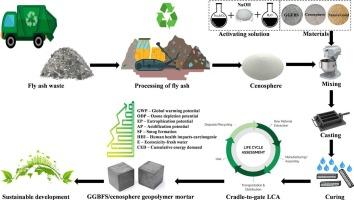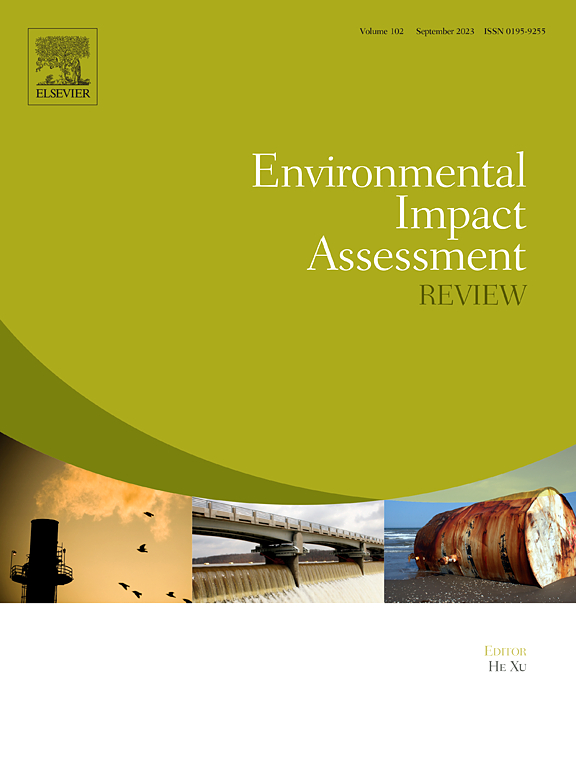Environmental assessment of cenosphere and GGBFS-based geopolymers: A path to greener construction materials
IF 9.8
1区 社会学
Q1 ENVIRONMENTAL STUDIES
引用次数: 0
Abstract
This study investigates the viability of utilizing cenospheres as an alternative precursor material for geopolymer formulation, comparing their performance against ground-granulated blast furnace slag (GGBFS) across various parameters such as strength, durability, cost, and environmental impacts. A cradle-to-gate life cycle assessment was performed to evaluate the environmental impact of geopolymer mixtures containing varying proportions of cenosphere and GGBFS, relative to conventional cement mortar (CM). Additionally, a multi-criteria decision-making (MCDM) analysis was employed by assigning varied importance levels to identify the optimal formulation derived from performance (strength and durability), cost, and environmental impact. The findings demonstrate that GGBFS/cenosphere-based geopolymers lower global warming potential (GWP) by 24–33 % compared to CM. Moreover, incorporating 25–75 % cenospheres in geopolymers reduces GWP by 4–7 % and energy consumption by 5 % compared to purely GGBFS-based geopolymers. The eutrophication potential (EP) and acidification potential (AP) were also reduced by 3–10 % and 5–15 %, respectively, by adding 25–75 % cenospheres in geopolymers. However, the cost is also increased by 6–18 %. Based on the MCDM analysis, geopolymers containing cenosphere possess higher overall sustainability than conventional cement-based mortars.

基于碳圈和 GGBFS 的土工聚合物的环境评估:绿色建筑材料之路
本研究调查了利用仙人球作为土工聚合物配方的替代前体材料的可行性,并比较了仙人球与粒化高炉矿渣(GGBFS)在强度、耐久性、成本和环境影响等各种参数方面的性能。此外,还进行了 "从摇篮到终点 "的生命周期评估,以评估土工聚合物混合物与传统水泥砂浆(CM)相比对环境的影响。此外,还采用了多标准决策(MCDM)分析法,通过分配不同的重要程度来确定从性能(强度和耐久性)、成本和环境影响中得出的最佳配方。研究结果表明,与 CM 相比,基于 GGBFS/碳圈的土工聚合物的全球升温潜能值 (GWP) 降低了 24-33%。此外,与纯粹基于 GGBFS 的土工聚合物相比,在土工聚合物中加入 25-75% 的仙人球可将全球升温潜能值降低 4-7%,能耗降低 5%。在土工聚合物中添加 25-75 % 的仙人球后,富营养化潜能值 (EP) 和酸化潜能值 (AP) 也分别降低了 3-10 % 和 5-15 %。不过,成本也增加了 6-18%。根据 MCDM 分析,与传统的水泥基砂浆相比,含有仙人球的土工聚合物具有更高的整体可持续性。
本文章由计算机程序翻译,如有差异,请以英文原文为准。
求助全文
约1分钟内获得全文
求助全文
来源期刊

Environmental Impact Assessment Review
ENVIRONMENTAL STUDIES-
CiteScore
12.60
自引率
10.10%
发文量
200
审稿时长
33 days
期刊介绍:
Environmental Impact Assessment Review is an interdisciplinary journal that serves a global audience of practitioners, policymakers, and academics involved in assessing the environmental impact of policies, projects, processes, and products. The journal focuses on innovative theory and practice in environmental impact assessment (EIA). Papers are expected to present innovative ideas, be topical, and coherent. The journal emphasizes concepts, methods, techniques, approaches, and systems related to EIA theory and practice.
 求助内容:
求助内容: 应助结果提醒方式:
应助结果提醒方式:


